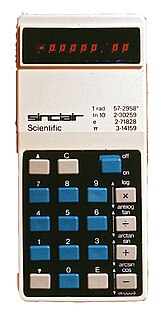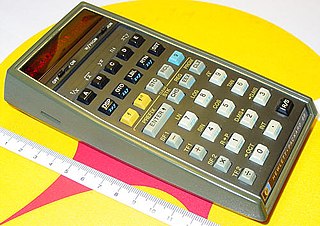
An electronic calculator is typically a portable electronic device used to perform calculations, ranging from basic arithmetic to complex mathematics.

The Intel 8080 ("eighty-eighty") was the second 8-bit microprocessor designed and manufactured by Intel and was released in April 1974. It is an extended and enhanced variant of the earlier 8008 design, although without binary compatibility. The initial specified clock rate or frequency limit was 2 MHz, and with common instructions using 4, 5, 7, 10, or 11 cycles this meant that it operated at a typical speed of a few hundred thousand instructions per second. A faster variant 8080A-1 became available later with clock frequency limit up to 3.125 MHz.
Reverse Polish notation (RPN), also known as Polish postfix notation or simply postfix notation, is a mathematical notation in which operators follow their operands, in contrast to Polish notation (PN), in which operators precede their operands. It does not need any parentheses as long as each operator has a fixed number of operands. The description "Polish" refers to the nationality of logician Jan Łukasiewicz, who invented Polish notation in 1924.
Very long instruction word (VLIW) refers to instruction set architectures designed to exploit instruction level parallelism (ILP). Whereas conventional central processing units mostly allow programs to specify instructions to execute in sequence only, a VLIW processor allows programs to explicitly specify instructions to execute in parallel. This design is intended to allow higher performance without the complexity inherent in some other designs.

The Intel 4004 is a 4-bit central processing unit (CPU) released by Intel Corporation in 1971. It was the first commercially available microprocessor, and the first in a long line of Intel CPUs. The chip design, implemented with the MOS silicon gate technology, started in April 1970, and was created by Federico Faggin who led the project from beginning to completion in 1971. Marcian Hoff formulated and led the architectural proposal in 1969, and Masatoshi Shima contributed to the architecture and later to the logic design. The first commercial sale of the fully operational 4004 occurred in March 1971 to Busicom Corp. of Japan for its 141-PF electronic calculator, for which it was originally designed and built as a custom chip.

The Sinclair Scientific calculator was a 12-function, pocket-sized scientific calculator introduced in 1974, dramatically undercutting in price other calculators available at the time. The Sinclair Scientific Programmable, released a year later, was advertised as the first budget programmable calculator.

The HP-65 is the first magnetic card-programmable handheld calculator. Introduced by Hewlett-Packard in 1974 at an MSRP of $795, it featured nine storage registers and room for 100 keystroke instructions. It also included a magnetic card reader/writer to save and load programs. Like all Hewlett-Packard calculators of the era and most since, the HP-65 used Reverse Polish Notation (RPN) and a four-level automatic operand stack.
In computer science, computer engineering and programming language implementations, a stack machine is a type of computer. In some cases, the term refers to a software scheme that simulates a stack machine.
RPL is a handheld calculator operating system and application programming language used on Hewlett-Packard's scientific graphing RPN calculators of the HP 28, 48, 49 and 50 series, but it is also usable on non-RPN calculators, such as the 38, 39 and 40 series.

In computer engineering, microarchitecture, also called computer organization and sometimes abbreviated as µarch or uarch, is the way a given instruction set architecture (ISA) is implemented in a particular processor. A given ISA may be implemented with different microarchitectures; implementations may vary due to different goals of a given design or due to shifts in technology.

The Signetics 2650 was an 8-bit microprocessor introduced in mid-1975. According to Adam Osborne's book An Introduction to Microprocessors Vol 2: Some Real Products, it was "the most minicomputer-like" of the microprocessors available at the time.

The Digi-Comp I was a functioning, mechanical digital computer sold in kit form. It was originally manufactured from polystyrene parts by E.S.R., Inc. starting in 1963 and sold as an educational toy for US$4.99.
The Monroe Calculating Machine Company was a maker of adding machines and calculators founded in 1912 by Jay Randolph Monroe based on a machine designed by Frank Stephen Baldwin. Now known as Monroe Systems for Business, the company was also known as Monroe Calculating Machine Company,Monroe THE Calculator Company, and Monroe Division of Litton Industries.
A stack register is a computer central processor register whose purpose is to keep track of a call stack. On an accumulator-based architecture machine, this may be a dedicated register such as SP on an Intel x86 machine. On a general register machine, it may be a register which is reserved by convention, such as on the PDP-11 or RISC machines. Some designs such as the Data General Eclipse had no dedicated register, but used a reserved hardware memory address for this function.
The history of general-purpose CPUs is a continuation of the earlier history of computing hardware.

The Olivetti Programma 101, also known as Perottina or P101, is the first commercial programmable "desktop computer". Produced by Italian manufacturer Olivetti, based in Ivrea, Piedmont, and invented by the Italian engineer Pier Giorgio Perotto, the P101 has the main features of large computers of that period. It was launched at the 1964 New York World's Fair; volume production started in 1965. A futuristic design for its time, the Programma 101 was priced at $3,200 (equivalent to $25,400 in 2018). About 44,000 units were sold, primarily in the US.

The HP 35s (F2215A) is a Hewlett-Packard non-graphing programmable scientific calculator. Although it is a successor to the HP 33s, it was introduced to commemorate the 35th anniversary of the HP-35, Hewlett-Packard's first pocket calculator. HP also released a limited production anniversary edition with shiny black overlay and engraving "Celebrating 35 years".
The Capricorn family of microprocessors was developed by Hewlett-Packard in the late 1970s for the HP series 80 scientific microcomputers. Capricorn was first used in the HP-85 desktop BASIC computer, introduced in January 1980. Steve Wozniak was inspired to build the Apple to be a computer like the HP 9830, and in 1976 he offered HP rights to the Apple computer. He was turned down and was given a release. When the calculator division started an 8 bit computer project called Capricorn, he left for Apple when he wasn't allowed to work on that project.

The Sharp QT-8D Micro Compet, a small electronic desktop calculator, was the first mass-produced calculator to have its logic circuitry entirely implemented with LSI integrated circuits (ICs) based on MOS (metal-oxide-semiconductor) technology. When it was introduced in late 1969, it was one of the smallest electronic calculators ever produced commercially. Previous electronic calculators had been about the size of a typewriter and had logic circuits built from numerous discrete transistors and diodes or small- to medium-scale ICs. The QT-8D's logic circuits were packed into just four LSI ICs.











